
The major aromatic product C in the following reaction sequence will be:

(1)
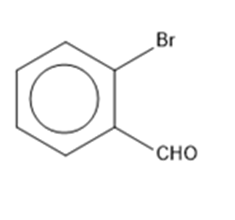
(2)
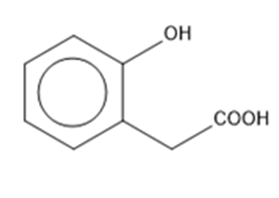
(3)
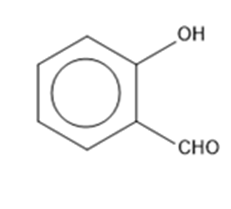
(4)
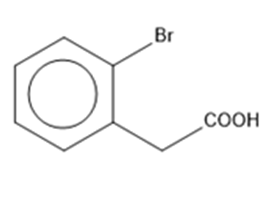
Answer
220.8k+ views
Hint: HBr is an example of an inorganic compound. HBr and its aqueous solution are useful as a reagent in the preparation of bromine compounds. HBr, when undergoing reaction with an alkene, forms a complex of alkyl bromide. HBr undergoes a reaction with alcohol to give an alkyl bromide as a product.
Complete Step by Step Solution:
The reaction of ketone with HBr in excess results in the breaking of the bond. The reaction is as follows:
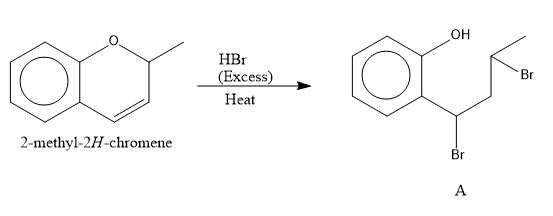
Image: Reaction of ketone with HBr
As the HBr is in excess, so, the bromination at the o and p position takes place.
The next step is the reaction of A with alcoholic potassium hydroxide in presence of acid. The reaction of an alkyl halide in alcoholic potassium hydroxide results in the removal of halogen acid to form an alkene.
So, the reaction is,
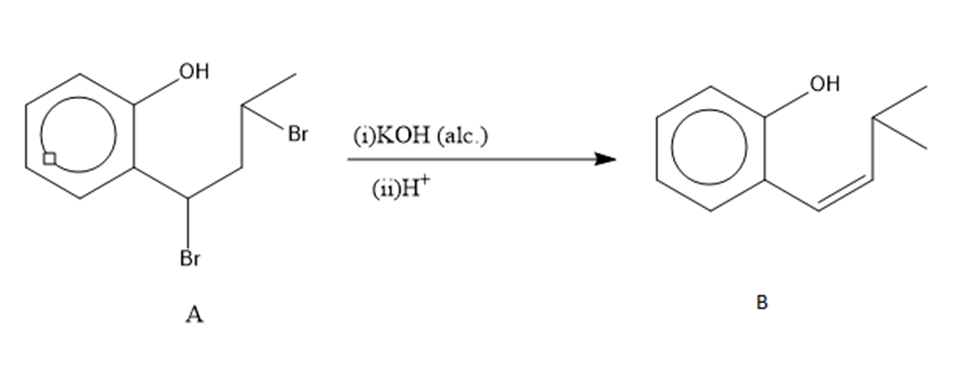
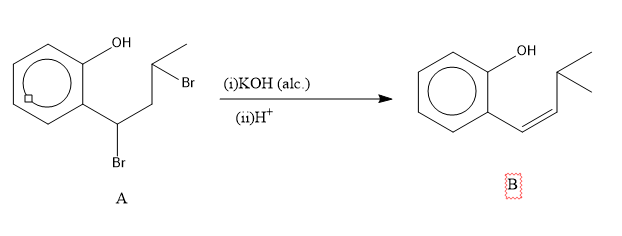
Image: Reaction of A with alcoholic potassium hydroxide in presence of acid
The next step is the reaction of B with Ozone in the presence of acid.
Image: Reaction of B with Ozone in presence of acid
This is an ozonolysis reaction. Ozonolysis is a reaction in organic chemistry where the breaking of double or triple bonds of alkynes, alkenes or azo compounds takes place in reaction with ozone. Alkynes and alkenes form organic compounds where the replacement of multiple carbon-carbon bonds takes place by a carbonyl group whereas azo compounds give nitrosamines.
Hence, the product C is in option C.
Note: Students often get confused between the reaction of an alkyl halide with aqueous and alcoholic KOH. It is to be noted that the reaction of an alkyl halide with alcoholic KOH gives alkene as a product. But, when alkyl halide undergoes a reaction with aqueous KOH, it gives alcohol as a product.
Complete Step by Step Solution:
The reaction of ketone with HBr in excess results in the breaking of the bond. The reaction is as follows:

Image: Reaction of ketone with HBr
As the HBr is in excess, so, the bromination at the o and p position takes place.
The next step is the reaction of A with alcoholic potassium hydroxide in presence of acid. The reaction of an alkyl halide in alcoholic potassium hydroxide results in the removal of halogen acid to form an alkene.
So, the reaction is,


Image: Reaction of A with alcoholic potassium hydroxide in presence of acid
The next step is the reaction of B with Ozone in the presence of acid.
Image: Reaction of B with Ozone in presence of acid

This is an ozonolysis reaction. Ozonolysis is a reaction in organic chemistry where the breaking of double or triple bonds of alkynes, alkenes or azo compounds takes place in reaction with ozone. Alkynes and alkenes form organic compounds where the replacement of multiple carbon-carbon bonds takes place by a carbonyl group whereas azo compounds give nitrosamines.
Hence, the product C is in option C.
Note: Students often get confused between the reaction of an alkyl halide with aqueous and alcoholic KOH. It is to be noted that the reaction of an alkyl halide with alcoholic KOH gives alkene as a product. But, when alkyl halide undergoes a reaction with aqueous KOH, it gives alcohol as a product.
Recently Updated Pages
Difference Between Alcohol and Phenol: Structure, Tests & Uses

Classification of Drugs in Chemistry: Types, Examples & Exam Guide

Class 12 Chemistry Mock Test Series for JEE Main – Free Online Practice

Is PPh3 a strong ligand class 12 chemistry JEE_Main

Full name of DDT is A 111trichloro22bispchlorophenyl class 12 chemistry JEE_Main

Sodium acetate on heating with soda lime produce A class 12 chemistry JEE_Main

Trending doubts
JEE Main 2026: Application Form Open, Exam Dates, Syllabus, Eligibility & Question Papers

Derivation of Equation of Trajectory Explained for Students

Hybridisation in Chemistry – Concept, Types & Applications

Understanding the Angle of Deviation in a Prism

How to Convert a Galvanometer into an Ammeter or Voltmeter

Degree of Dissociation: Meaning, Formula, Calculation & Uses

Other Pages
Solutions Class 12 Chemistry Chapter 1 CBSE Notes - 2025-26

NCERT Solutions For Class 12 Chemistry Chapter 1 Solutions - 2025-26

The D and F Block Elements Class 12 Chemistry Chapter 4 CBSE Notes - 2025-26

NCERT Solutions for Class 12 Chemistry Chapter Chapter 7 Alcohol Phenol and Ether

NCERT Solutions ForClass 12 Chemistry Chapter Chapter 8 Aldehydes Ketones And Carboxylic Acids

JEE Advanced Marks vs Ranks 2025: Understanding Category-wise Qualifying Marks and Previous Year Cut-offs




